76
Open Access
The Relationship Between Coronary Artery Calcification and Bone Mineral Density in Patients
According to Their Metabolic Syndrome Status
Hyung Tak Lee, MD
1, Jinho Shin, MD
1, Young-Hyo Lim, MD
1, Bae Keun Kim, MD
1, Young Taek Kim, MD
1, Jae Ung Lee, MD
1, Sangmo Hong, MD
2, Soon Young Song, MD
3and Sam Hyun Cho, MD
41
Division of Cardiology,
2Endocrinology and Metabolism, Departments of Internal Medicine,
3Radiology and
4Obsterics and Gynecology, Hanyang University College of Medicine, Seoul, Korea
ABSTRACT
Background and Objectives: The extent of coronary artery calcification (CAC) is closely related to total atherosclerotic plaque burden. However, the pathogenesis of CAC is still unclear. Conditions such as diabetes mellitus, renal failure, smoking, and chronic inflammation have been suggested to link vascular calcification and bone loss. In the present study, we hypothe- sized that bone loss can contribute to the pathogenesis of CAC in patients with the chronic inflammatory condition that ac- companies metabolic syndrome (MetS). The objective of this study was to investigate the relationship between CAC and bone mineral density (BMD) in patients with MetS and in patients without MetS, by using coronary multidetector-row computed tomography (MDCT). Subjects and Methods: Data from 395 consecutive patients was analyzed retrospectively. From the MDCT database, only those patients who underwent both coronary MDCT and dual-energy X-ray absorptiometry within an interval of one month, were selected. The presence of MetS was determined by the updated criteria as defined by the Third Adult Treatment Panel Report of the National Cholesterol Education Program. Results: In patients with MetS, a significant correlation was found between CAC and age {odds ratio (OR)=1.139, 95% confidence interval (CI) 1.080 to 1.201, p<0.001}, CAC and male sex (OR=3.762, 95% CI 1.339 to 10.569, p=0.012), and CAC and T-score of L-spine (OR=0.740, 95% CI 0.550 to 0.996, p=0.047) using a forward multiple logistic regression analysis model including clinical variables of gender, age, lipid profile, body mass index, diabetes mellitus, hypertension, smoking, and BMD. But in patients without MetS, BMD by itself was not found to contribute to CAC. Conclusion: BMD was inversely correlated with CAC only in patients with MetS. This find- ing suggests that low BMD accompanied by MetS, may have significant clinical implications. (Korean Circ J 2011;41:76-82) KEY WORDS: Bone density; Metabolic syndrome X; Coronary artery disease.
Received: June 8, 2010 Revision Received: July 1, 2010 Accepted: July 21, 2010
Correspondence: Jinho Shin, MD, Division of Cardiology, Department of Internal Medicine, Hanyang University College of Medicine, 17 Haeng- dang-dong, Seongdong-gu, Seoul 133-792, Korea
Tel: 82-2-2290-8308, Fax: 82-2-2298-9183 E-mail: jhs2003@hanyang.ac.kr
• The authors have no financial conflicts of interest.
cc

